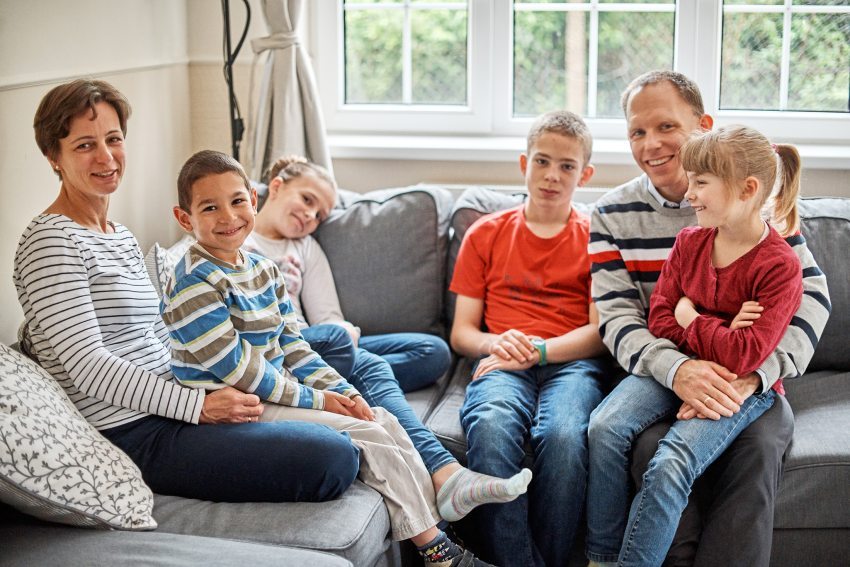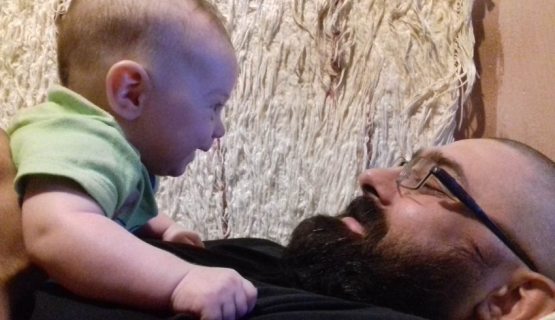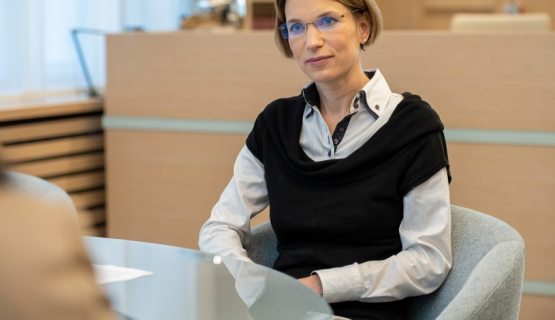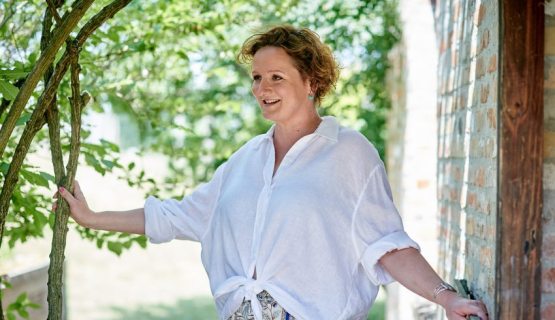“It is no secret and no insult that he is a Gypsy” – the story of an adoption
“We had to fill out a form in the Child Welfare Agency about the age and state of health of the child we would be willing to adopt. Officially one is not permitted to designate racial affiliation but everyone knows that if somebody writes they would like a blond, blue-eyed child, this means not Gypsy. We simply wrote down boy, up to three years old. From then on we knew that almost certainly we would get a three-year-old Gypsy boy.” This is how Zsolt arrived as the fourth in a three-child family to the adoptive parents, János Simon and Boglárka Németh S., two and a half years after his birth mother rejected him. A Hungarian story.

Boglárka: “Zsófi must have been three, Kata six and Dani nine when we suddenly thought it would be great to have a fourth child. However, a further pregnancy would have represented a huge burden. Due to a genetic disease, it was not even sure that I could give birth so at the beginning of our marriage we made it clear that if things worked out this way, then we would adopt. After three children we felt we could handle another.”
János: “It took a year for us to get all the official paperwork together. The preparatory course was held at the Ágacska Foundation. During the course, certain aspects of adoption were raised that we had never even thought of. A person is liable to just brush it off by saying: we adopt a child and that’s that, what’s so complicated. However, they removed the rose-tinted spectacles from us and this was extremely useful.”
What do you mean?
János: “They spoke a lot about motivation.
“For example, if a couple want to adopt merely to replace somebody, instead of just adopting a person, that is dangerous. In the same way, if we are solely thinking in ‘charitable’ terms, and we do not feel the deep-seated urge to adopt, then we shouldn’t say yes.
“Families are sought for children who were born from an unwanted pregnancy, that is why even new-borns are damaged, and older ones even more so. However, adoption is forever, as the name implies (in Hungarian, ‘örökbefogadás’ which is literally ‘receiving forever’). In adoption, there is no such thing as ‘if we don’t get on well then I’ll send the child back and ask for the next one in case things work out better’.”
Boglárka: “Anybody who excludes the adoption of a child of Gypsy extraction from the outset should really consider whether they are truly ready for adoption. The fact is, if they exclude somebody purely on the basis of racial affiliation, then they will not be able to accept the child’s less appealing personal traits. We heard a lot about attachment, which is very important for the child to be able to fit into the family without harm. For example, the child who runs to you at first sight and hugs your leg and begs you, ‘Take me home!’, probably cannot attach. There is a danger that in that moment when there is conflict, he/she will go away with the next person, or as an adult he/she will be unable to form a lasting partnership.”
So, the process started. What came next?
Boglárka: “In October 2015, we received all the papers. At the very end of November we got a phone call that there was a little boy on the other side of the country. First we saw a poor photograph and a misinterpreted case history, and we had to say yes or no to that. We clarified the clinical picture and we thought it would not be possible to come to a decision on the basis of a photograph. We indicated that we would like to meet him.”
János: “Zsolt was left in the hospital by his birth mother, from where he first went to foster parents and then at five months he was given to another family. In his case, it was a secret adoption, that is, we were not allowed to meet the biological parents, but still we managed to piece together some of what had happened. It is certain that it was a major break for Zsolt when at the age of barely six months he was moved from one foster home to another.
“We also know that the family we collected Zsolt from loved him enormously and brought him up as if he were their son, but since adoption does not come with any financial support, only for foster parent status, they voluntarily gave him up.”
Boglárka: “In early December we met them at the local child welfare agency. This is when they were hit by the realization that Zsolt would be taken from them. Then they did their utmost that this wouldn’t happen. They immediately said: ‘You can see that he is a Gypsy, can’t you?’ They were themselves Roma. This didn’t bother us because we were confident that this is how it would be. After this there was a little delay but because Zsolt would have been taken away from them anyway, we didn’t want to withdraw. We had merely half an hour with him at the first meeting. We knew we couldn’t force play and the approach, but we had to accept that we were strangers for the child.”
János: “This is good over the long term because it indicates that he is able to attach. Zsolt was not cuddly, he didn’t run to the arms of his foster parents but instead sat on the carpet pushing a car. Later, when he was with us, he kept this habit for a while, if he had any problems he stood in one place, he did not run to us. We were watching our first impressions and whether we could sincerely accept him or not. We knew since attending the course that if only one of us felt no, then it meant no for both. But luckily, in our case this was not like this. Zsolt was a really smiley, cheerful little child and much nicer than in the pictures. He totally charmed us with his eyes. There was no question that we wanted to see him again but the next day we had to call them again to prove that this was not done merely out of fleeting excitement.”
Did your children know about him?
János: “When we first mentioned this to them, we were already arranging the papers and I have to say that they were not pleased. Their first reaction was that we were enough, but if another child had to come, then at least he should not be adopted. Our oldest child was most against this, he was just reaching his teens and he was always thinking about what other people would say about the adoption and, as he put it, he had already ‘suffered’ enough with two younger sisters. There was a lot of emphasis on the course about the successfulness of adoption depending on how much the parents are able to accept it and how they communicate the fact to the outside.
“When a birth sibling arrives in the family, it is the same thing: it is not in the siblings’ competence but the parents’ whether there should be another child in the family. We invited them to come and see Zsolt and if they had any problems we could discuss the matter, but we made them understand that it was not their decision.
“The negative attitude only lasted up until the moment that they met Zsolt. In that minute, the wall collapsed.”
Boglárka: “In December, we went to visit him more often and for longer each time, despite the 200 km distance. At the beginning, the foster parents only went through to the other room, then they left the building, and finally we took Zsolt away for a little while. By that time he understood that something was going on and he was crying more and more. It was most difficult for him to know who exactly he belonged to. Then the time arrived that we could bring him home for three days between the two holidays. After we took him back, we indicated again that we would certainly like to adopt him and because he was crying a lot we also said that we would like to take him home with us as soon as possible. We took him home for good on 14 January.”
How did the process of attachment go?
János: “Our children immediately became friends with him. At that time there were magnetic letters on the fridge door, from which the kids had spelled out their names earlier. Once, Dani came to me and said that there were not enough letters but he had found out how to spell out the names of all four of them in the form of a crossword. At this moment I felt that Dani had accepted his younger brother. Zsolt needed more time to attach. The experience is that this attachment will be deep when he has spent as much time with the family as elsewhere. More or less, this was correct. When he started kindergarten, we had to tell the teachers to watch him because if the door was left open and somebody smiled at him pleasantly, then he would go away with them.”
It couldn’t have been easy getting on the same wavelength as Zsolt because you didn’t know anything about him.
János: “One of our relatives said it was like when you start watching a series but only in the middle of the second season. A good part of the prequels can only be inferred.”
Boglárka: “At the beginning, he hated water, probably due to an earlier traumatic experience, so the evening bath was a real torture for months. We had problems with eating as well. When he came to us, he lived on cocoa drunk from a baby bottle. He almost couldn’t swallow solids. One of his forms of protest was retching up food without a word. It was sufficient, he had eaten enough, but he didn’t try to say this out loud. Finally, we taught him that he should tell us what the problem was instead of vomiting the food.”
János: “Furthermore, we came across a big task right at the beginning: since the foster parents had not told him that they were not his biological parents, we had to tell him. We told him what vicissitudes he had gone through and that now he was going to be with us forever, he was our son and would never leave us. Up to this point he had cried a lot but after this talk everything changed. We were surprised that a two-and-a-half-year-old child understood this.”
Did anything ever make you feel that he had been born from an unwanted pregnancy?
János: “Yes. At the beginning he was invisible and not heard in the house. He instinctively hid because he didn’t want to disturb anybody. For months we didn’t know where he was because he kept very quiet. We saw that he was starting to enjoy things when on entering the house we could hear where he was.”
How easy was it for you to declare his Gypsy origin in your immediate environment?
Boglárka: “I remember when his origin came to light in the family, there was somebody who tried to warn us that we would have many problems with him. We said that this was our problem and we accepted it. However, since then Zsolt is the favourite of that member of the family. If we insist that this is not a problem, then the environment accepts it like this. Luckily, the kindergarten and school where the children go is open and receptive.
“We know that Dani also accepts this when once one of his classmates started to tell a Gypsy joke and he told him: ‘You know my younger brother is Gypsy, don’t you? Now, carry on!” It is no secret and no insult that he is a Gypsy.
“We had to make it clear in ourselves what is prejudice and what is reality. Are we susceptible to seeing something behind an observation that is not actually there, and are we able to distinguish this? It happened that we caught Zsolt fibbing and we looked up suddenly because we were prejudiced. We had to rethink whether we overreacted, being afraid that he was doing this because he was a Gypsy.
“Zsolt came from an environment lacking in stimulation, two and a half years in such circumstances is a long time. When he came to us, he didn’t pay attention to conversation, he wasn’t interested in fairy tales, he couldn’t play with others, and he didn’t engage with his environment. Now he is very sad if we don’t read to him in the evening. He has a very good memory, perhaps better than the others. In other areas he is making up for the backlog at a furious pace and in the meantime he is of great joy to us. Many are unwilling to adopt an older or non-white child. One should not be frightened of this, difficulties do not derive from that.”








